#hyaenodonts
Text
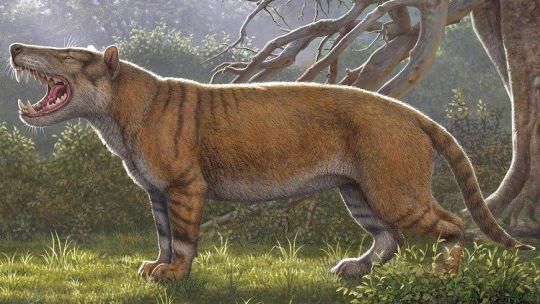
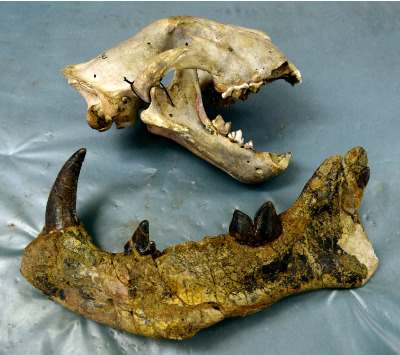
October's Fossil of the Month - Simbakubwa (Simbakubwa kutokaafrika)
Family: Hyena Cat Family (Hyainailouridae)
Time Period: 23-22 Million Years Ago (Early Neogene)
Currently known only from fossilised teeth and lower jaws discovered in Kenya's Messa Bridge fossil site, Simbakubwa kutokaaffrika was originally described as a prehistoric species of hyena before reexamination of fossils housed at the Nairobi National Museum of Kenya led to it being reclassified as a hyaenadont (a member of the extinct order Hyaenadonta, the members of which were generally dog-like animals with similar jaws and teeth to modern hyenas, although their teeth differed from true carnivorans today in that they lacked modified molars used for crushing and tearing seen in animals such as bears and dogs, and seemed to grow their teeth in slower than most modern carnivores.) While the limited variety of Simbakubwa fossils means that much of its biology is a mystery, it is notable among the hyaenadonts because of its size; estimates of its body size based on the size of its jaws suggest that, while most hyaenodonts were comparable to a large dog in size, it was at least as large as a lion, with the most generous estimates suggesting that it may have weighed as much as 1,500kg/3,307lbs (surpassing even modern Polar Bears in size,) although as the more complete fossils of related species suggest that members of the "hyena-cat" family of hyaenodonts that Simbakubwa belonged to had extremely large heads compared to their bodies it is unlikely that it actually reached such as size. Based on the shape of its teeth and the presumed strength of its jaws it is likely that Simbakubwa was purely carnivorous and fed on large mammals such as rhinoceros and gomphotheres (extinct relatives of modern elephants,) although based on the lack of any preserved teeth showing adaptations for crushing it is unclear if members of this species also fed on bones as other hyaenodonts and modern hyenas are known to do. While the circumstances of Simbakubwa's extinction are unclear, it is plausible that as the earth gradually became cooler and drier as it approached a series of "ice ages" in the later neogene resources became scarcer and large carnivores were among the first species to be affected by this. While the binomial names of most species are derived from Greek and/or Latin, Simbakubwa kutokaaffrika is Swahili, translating roughly to "great lion from Africa."
--------------------------------------------------------------------------
*Note - The second image above shows a Simbakubwa lower jaw (bottom) compared to a modern Lion skull (top.)
Image Sources: https://commons.wikimedia.org/wiki/File:Simbakubwa-kutokaafrika_2.jpg
and
https://www.nationalgeographic.com/science/article/new-species-ancient-carnivore-was-bigger-than-polar-bear-hyaenodonts
#Simbakubwa#hyeanodont#hyaenodonts#zoology#biology#paleontology#mammalogy#prehistoric wildlife#animal#animals#wildlife#African wildlife#African fossils#fossil#fossils#mammal#mammals#prehistoric animals#prehistoric mammals
245 notes
·
View notes
Text
It Came From The Wastebasket #08: Stem-Carnivoramorphs Do What Creodon't
Creodonts were some of the earliest predatory placental mammals to evolve after the extinction of the non-avian dinosaurs, first appearing in the mid-Paleocene about 60 million years ago. Represented by two main lineages – the oxyaenids and the hyaenodonts – they ranged across North America, Eurasia, and Africa, and were the dominant large carnivorous mammals until the end of the Eocene (~34 million years ago), with forms like Sarkastodon being some of the biggest mammalian land predators of all time.
After that point they started to decline over most of their range, gradually being replaced by early carnivorans – but the hyaenodonts retained their dominance for a while longer in Africa, diversifying during the Oligocene and early Miocene and producing more giant apex predators. The last known representatives of these animals survived in Asia until the late Miocene, just 9 million years ago, ending an impressive run that had lasted for most of the Cenozoic.
This grouping was originally named in the 1870s to encompass just the oxyaenids and Didymictis (a genus now considered to be a viverravid). Just a few years later hyaenodonts, miacids, arctocyonids, leptictids, and mesonychids were all lumped in, too – and at one point creodonts were even a part of the massive insectivoran mess before instead being classified as ancestors of the carnivorans.
During the first half of the 20th century creodonts were recognized as actually being a loose collection of mostly-unrelated mammals, and over the next few decades various groups were gradually removed and reassigned to other parts of the mammal family tree. Towards the end of the century most of the creodont wastebasket had been cleared, and just the oxyaenids and the hyaenodonts were left as two branches of one seemingly distinct creodont lineage.

The cougar-sized oxyaenid Patriofelis ferox (left) & the bear-sized hyaenodont Hyaenodon gigas (right)
…But their evolutionary relationships were still a problem.
They'd been traditionally considered to be early carnivorans, but although they had flesh-slicing carnassials the creodonts' versions of these teeth weren't quite right. Different teeth in their jaws had been specialized for this function compared to those of true carnivorans – with oxyaenids and hyaenodonts having slightly different arrangements compared to each other, too – suggesting a lot of convergent evolution rather than shared ancestry.
By the 1990s it wasn't clear anymore if the oxyaenids and hyaenodonts were even closely related to each other, or what type of mammal they actually were.
But over the last couple of decades the consensus seems to have become that creodonts weren't a single natural group, but that they were still related to carnivorans – oxyaenids and hyaenodonts were actually two separate offshoots of the Ferae, forming an evolutionary grade of stem lineages between pangolins and the carnivoramorphs.

———
Nix Illustration | Tumblr | Twitter | Patreon
#it came from the wastebasket#wastebasket taxon#taxonomy#creodonts#patriofelis#oxyaenid#hyaenodon#hyaenodont#pan-carnivora#ferae#mammal#paleontology#art#science illustration#paleoart#palaeoblr
228 notes
·
View notes
Photo

Simbakubwa kutokaafrika was a large predatory mammal that prowled Africa around 23 million years ago, during the early Miocene epoch. Approximating the size of a rhinoceros, it may have looked like a big cat with a dog- or hyena-like head, yet it belonged to another group of carnivorous mammals known as the hyaenodonts which died out around nine million years ago. It probably hunted primitive rhinos and elephant cousins, dispatching them with its large shearing teeth and powerful bite.
13 notes
·
View notes
Photo


top: man with megistotherium skull
bottom: simbakubwa mandible with african lion skull
3 notes
·
View notes
Text
Horny Indian Gf giving blowjob in Car
Teens Hookup & Scissor At Lesbian Yoga Class - GirlfriendsFilms
Naughty America Danielle Derek's boss uses her big tits and fills all holes
Sexy Lee Anne gets her wet pussy fucked
Sweet Teen Handjob With Orgasm Control Is The Best Medicine For COV-19
Filipina teen gets her pussy fucked by stud
Lusty amateur teen is ready to get fucked like not ever before
Fucking satisfyer man big dick white cock
Russian Teen Couple Fucks on a Couch
Girl Squirt Everywhere Multiple Times
#feral#race-riding#fellah#foot-running#tabatiere#imaginator#allelomorphism#dirt-fast#unwoefully#vizier#pseudobulb#boozing#impugnment#polyvalence#hyaenodont#voice-leading#jingoed#world-heating#prangs#Meshech
0 notes
Text
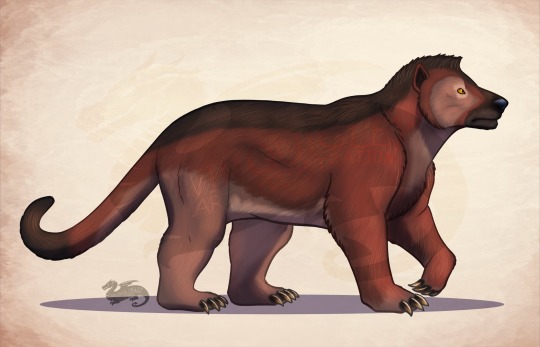
Paleovember 2023, Amphicyon!
Coming from the Miocene, the members of this genus and it's family are colloquially referred to as 'bear-dogs' due to possessing traits similar to both bears and dogs, whom they were related but not ancestral to. This was a widespread genus, ranging across Europe Africa, Asia, and North America, with the largest species, A. ingens, growing up to the size of a polar bear. These were adaptable and generalist hunters, able to subsist on a wide range of foods. This initially allowed amphicyonids to outcompete an earlier group of predators, the hyaenodonts. Ironically, though, this jack-of-all-trades approach failed with the arrival of modern, more specialized carnivoran groups, including cats, dogs, bears, and hyenas.
#amphicyon#bear dog#carnivora#mammal#illustration#miocene#paleoart#paleontology#cenozoic#prehistoric#art#artwork#cartoon#digitalart#procreate#artist on tumblr
31 notes
·
View notes
Text
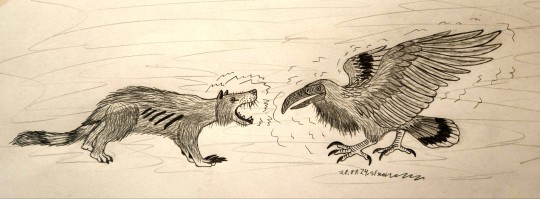
"Scavenger disagreement"
Anpucar vs Grey-bearded rainsnapper

Anpucar
A specialised scavenger of roa's woodlands and possibly the one and only hyaenodont of roa. Anpucar has a symbiosis with several flesh-eating bacteria , some insects and even fungi to better deal with carcasses and protect itself from getting infected. But it also made Anpucar more protected against predation , as a risk to get infected by it is very high. Even touching Anpucar can end up in being infected. Together with this , Anpucar doesn't hesistate to fight for a carcass. Using sharp bite and long front claws to give painful injuries. Sometimes so many flesh-eating bacteria or other companions can be near or inside it that it looks like it is covered in black cloud with purplish air coming from it's mouth.

Grey-bearded rainsnapper
An omnivorous teratornithid found in rainforests of roa. Those are big opportunists which will eat practically anything. Huge beak is both good at crushing nuts and occasional small animals. Sickle claw on legs is used mostly to help tear down meat on carcass or for climbing. They are solitary but will often gather together around carcasses. One of the biggest and weirdest birds of roa.
13 notes
·
View notes
Note
Shortened version of whats below:
TL;DR: name of species: Machairodontinae its a saber tooth cat idk how to describe it but ye
Longer version:
The Machairodontinae contain many of the extinct predators commonly known as "saber-toothed cats", including the famed genus Smilodon, as well as other cats with only minor increases in the size and length of their maxillary canines. The name means "dagger-tooth", from Greek μάχαιρα (machaira), sword. Sometimes, other carnivorous mammals with elongated teeth are also called saber-toothed cats, although they do not belong to the felids. Besides the machairodonts, other saber-toothed predators also arose in the nimravids, barbourofelids, machaeroidines, hyaenodonts and even in two groups of metatherians (the thylacosmilid sparassodonts and the deltatheroideans).
The Machairodontinae originated in the early or middle Miocene of Africa.[citation needed] The early felid Pseudaelurus quadridentatus showed a trend towards elongated upper canines, and is believed to be at the base of the machairodontine evolution. The earliest known machairodont genus is the middle Miocene Miomachairodus from Africa and Turkey. Until the late Miocene, machairodontines co-existed at several places together with barbourofelids, archaic large carnivores that also bore long sabre-teeth. Traditionally, three different tribes of machairodontines were recognized, the Smilodontini with typical dirk-toothed forms, such as Megantereon and Smilodon, the Machairodontini or Homotherini with scimitar-toothed cats, such as Machairodus or Homotherium, and the Metailurini, containing genera such as Dinofelis and Metailurus. However, some have recently regrouped the Metailurini within the other felid subfamily, the Felinae, along with all modern cats. The last machairodontine genera, Smilodon and Homotherium, did not disappear until late in the Pleistocene, roughly 10,000 years ago in the Americas.Based on mitochondrial DNA sequences extracted from fossils, the lineages of Homotherium and Smilodon are estimated to have diverged about 18 Ma ago. The name 'saber-toothed tigers' is misleading. Machairodonts were not in the same subfamily as tigers, there is no evidence that they had tiger-like coat patterns, and this broad group of animals did not all live or hunt in the same manner as the modern tiger. DNA analysis published in 2005 confirmed and clarified cladistic analysis in showing that the Machairodontinae diverged early from the ancestors of modern cats and are not closely related to any living feline species. Saber-tooths also coexisted in many places with conical-toothed cats. In Africa and Eurasia, sabertooth cats competed with several pantherines and cheetahs until the early or middle Pleistocene. Homotherium survived in northern Europe even until the late Pleistocene. In the Americas, they coexisted with the cougar, American lion, American cheetah, and jaguar until the late Pleistocene. Saber-toothed and conical-toothed cats competed with each other for food resources, until the last of the former became extinct. All recent felids have more or less conical-shaped upper canines.
The jaws of machairodonts, especially more derived species with longer canines, such as Smilodon and Megantereon, are unusually weak. Digital reconstructions of the skulls of lions and of Smilodon show that the latter would have fared poorly with the stresses of holding onto struggling prey. The main issue was the stresses suffered by the mandible: a strong force threatened to break the jaw as pressure was placed on its weakest points.Smilodon would have had one-third the bite force of a lion, had it used only its jaw muscles. However, the neck muscles that connected to the back of the skull were stronger and depressed the head, forcing the skull down. When the jaw was hyper-extended, the jaw muscles could not contract, but the neck muscles pressed the head down, forcing the canines into whatever resisted them. When the mouth was closed far enough, the jaw muscles could raise the mandible by some margin.
On occasion, the bone of a fossilised predator is preserved well enough to retain recognizable proteins that belong to the species it consumed when alive. Stable isotope analysis of these proteins has shown that Smilodon preyed mainly on bison and horses, and occasionally ground sloths and mammoths, while Homotherium often preyed on young mammoths and other grazers such as pronghorn antelope and bighorn sheep when mammoths were not available. Examinations published in 2022 of tooth wear patterns on Smilodon and bite marks on the bones of the peccary Platygonus by Xenosmilus suggest that machairodonts were capable of efficiently stripping and de-fleshing a carcass of meat when feeding. They also show a degree of bone consumption on par with that of modern lions, which themselves can and regularly do eat smaller bones when consuming a meal
behind the carnassials. Regardless, reconstructions of Smilodon, Machairodus, and other species are shown with long lips, often resembling the jowls of large dogs.Studies of Homotherium and Smilodon published in 2022 by Mauricio Anton et al., suggest that scimitar-toothed machairodonts like Homotherium itself possessed upper lips and gum tissue that could effectively hide and protect their upper canines; a trait they shared in common with modern cat species, while Smilodon had canines that remained partially exposed and protruded past the lips and chin even while the mouth was closed due to their great length.
Comparisons of the hyoid bones of Smilodon and lions show that the former, and possibly other machairodonts, could potentially have roared like their modern relatives.
A 2009 study compared the ratios of social and solitary carnivores in reserves in South Africa and Tanzania with those of fossils of California's La Brea tar pits, a well-known fossil bed from the Pleistocene, and how they responded to recorded sounds of dying prey, to infer whether Smilodon was social or not. At one time, the La Brea tar pits consisted of deep tar in which animals became trapped. As they died, their calls attracted predators, which in turn also became caught. It is considered the best Pleistocene fossil bed in North America for the number of animals caught and preserved in the tar, and may be similar to the situation created in the study. The assumption was that solitary carnivores would not approach the sources of such sounds, because of the danger of confrontation with other predators. Social carnivores, such as lions, have few other predators to fear, and will readily attend these calls. The study concluded that this latter situation most closely fit the ratio of animals found at the La Brea tar pits, and therefore that Smilodon was most likely social.
These cats were tenacious and adaptable animals, thriving for hundreds of thousands of years before their time finally came to an end. Saber-toothed cats went extinct between 8,000 and 10,000 years ago, as the ice age drew to an end and their prey began to die out.
many of the extinct predators commonly known as "saber-toothed cats", including the famed genus Smilodon, as well as other cats with only minor increases in the size and length of their maxillary canines. The name means "dagger-tooth", from Greek μάχαιρα (machaira), sword. Sometimes, other carnivorous mammals with elongated teeth are also called saber-toothed cats, although they do not belong to the felids. Besides the machairodonts, other saber-toothed predators also arose in the nimravids, barbourofelids, machaeroidines, hyaenodonts and even in two groups of metatherians (the thylacosmilid sparassodonts and the deltatheroideans).
No pictures for you I'll send you some If you GO TO BED MY GOD MARS SLEEP
I. Caant readd rjoght bow💥💥💥💥💥💥💥💥
10 notes
·
View notes
Text
@lonetala liked for a fun fact!

"Don't let the name fool you--Hyaenodon wasn't closely related to hyenas at all, or any member of the modern Carnivora, for that matter. There's nothing quite like Hyaenodonts alive today, though you'd be forgiven for mistaking them for a canine or something if you saw a live one."
3 notes
·
View notes
Text
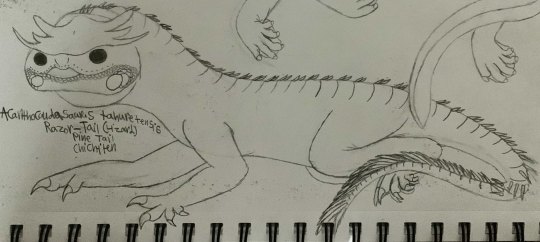
Razortail/Pinetail/Chichilen
Kingdom: Animalia
Phylum: Chordata
Class: Reptilia
Clade: Archosauromorpha
Clade: Crocopoda
Order: Rhynchosauria
Family: incertae sedis
Genus: Acanthocaudasaurus
Species: A. tahuretensis (“Tahureti spiny-tailed lizard”, “Tahureti” being a demonym for the historical region of Tahuret, a jungle and dry forest kingdom in northern Xenogaea)
Temporal range: Holocene to recent (10,000 kya - present); genetic divergence suggests a probable Miocene origin (10 mya - present).
Information:
A member of the rhynchosaur clade, this reptile’s placement within its own family is a contentious topic, in part due to its mix of basal and derived features. There are three competing theories regarding this, however: the first is that the razortail is a basal rhynchosaur which has convergently evolved derived rhynchosaur features (such as a partially beaked jaw), the second is that it is a derived rhynchosaur which has re-evolved several atavistic traits (such as the more slender, lizard-like build of earlier members of the clade), and the third and most widely-accepted theory being that it represents an early offshoot of the lineage leading to more derived forms, a so-called “missing link” between the two. Alas, this is not the only thing which makes this species quite unique compared to other members of its clade: an unusual example of an omnivore coming from an ancestrally herbivorous lineage, the razortail’s diet is best described as “indiscriminate”. Its main food sources consist largely of palm fronds, fallen fruits, nuts, seeds, large arthropods, small vertebrates (though it especially takes a liking for the multituberculates which share its habitat), and even eggs, the latter of which it actively seeks out. Individuals living in cities have been observed to even go after stray dogs and cats, as well as feral pigeons. Scavenging is also frequent, and cannibalism is documented but rare. Of course, with such indiscriminate dietary habits comes a high ecological pressure for competition, and as such, the razortail is fiercely territorial and reactive. However, while it extends such aggression towards its own kin mercilessly, rarely if ever tolerating the company of other razortails outside of its small hunting group, known as a caravan, with other animals, it is the embodiment of the phrase “its bark is worse than its bite”: it tends to flee from threats it does not believe it can successfully intimidate, though it may puff itself up and hiss and gurgle towards those it believes it can intimidate, throwing its spiny tail in front of it to add to the display. If approached or handled further, it may lunge forward, hissing and gurgling even more loudly, and will only bite if all else fails. The bite of this animal is deceptively strong, and can be strong enough to sever fingers and toes. That said, the amount of provocation it takes to get to this point is extreme, and to get bitten by this animal practically requires you to go looking to get bitten. Unfortunately, this animal often lives near human settlements, in part due to the easy source of food that is refuse piles and in part due to its acquired liking for coconuts and bananas, crops imported during medieval times by Austronesian sailors. As such, its relationship with the native inhabitants of the region is complicated, being simultaneously valued for its prowess for hunting the multituberculates and rodents which commonly eat crops but also detested or its own proclivity towards eating these crops itself.
Despite being only around the size of a Komodo dragon, this animal’s reputation far precedes it in the jungles and dry forests (and increasingly the neighboring grasslands) it calls home: this animal’s tendency to square up against significantly larger troodonts, dromaeosaurs, and even hyaenodonts has earned it the moniker of the “bulldog lizard” in some areas. Alas, this animal also squares up against rauisuchids and medium-sized theropods. So reviled is this creature by the animals it shares its ecosystem with, that dinosaurs which have lost chicks to razortails will abandon entire nests and start anew. Nonetheless, this animal is also preyed upon by the most brazen predators, its catalogue of predators including large theropods, amphicyonids, saber-toothed cats, prestosuchids, phytosaurs, hyaenids, hyaenodonts, oxyaenodonts, marsupial lions, sparassodonts, and humans. As such, this animal’s mottled, vibrant green and brown coloration is an adaptation which allows it to blend in with the foliage of its home. Another unique adaptation this animal has is its metabolism: a rare example of a heterothermic non-archosaurian diapsid, the razortail is able to inefficiently moderate its own internal temperature. However, as this is energetically costly, it typically relies on the surrounding environment to regulate its body temperature. With superb eyesight, the razortail is cathemeral and is able to be active in both the high afternoon sun and the pitch black of the midnight, hauling itself into the trees with its powerful forelimbs to sleep in the branches when not foraging or socializing. Able to run at speeds of up to 30 mph, this animal is also well-adapted for running fast in short bursts, something which aids it both in hunting and in fleeing from predators. This species appears to be uniquely resistant to the venom of many hymenopterans and snakes, the venom only knocking it unconscious for an hour or two before being metabolized. As such, it has little if any issue feeding on the nests of bees and wasps and is one of the few animals which control venomous snake populations. Some evidence suggest it engages in a form of commensalism with some species of therocephalians living in the same region as it, the more endothermic and muscular therocephalians serving as the brute force needed to make the kill while the razortails serve as the speed needed to corral prey into waiting jaws. This animal is quite versatile as well, and can regenerate damaged body parts with ease, even being able to regenerate parts of its eye if damaged. This species is one of the most successful in Xenogaea from a conservation standpoint, numbering nearly 2 million animals and counting, and its adaptability has allowed it to colonize previously uncharted territory for its species over a relatively short period of time, with most evidence pointing towards this species undergoing a distributive radiation. Likewise, this species’ presence in its native range is likely vital to the spread of the Xenogaean jungle pine, an araucarian conifer species found throughout the northern stretches of the Isle of Perils, as the razortail eats the cone by first crushing them before consuming them, spreading a few stray seeds on the ground in the process and allowing others to pass through its bowels to be excreted in its urea. Another thing to note about this bizarre creature is that the teeth at the front of the lower lip are fused into an exposed, bony plate whereas those on the top are concealed by lips.
In the winter months, when the tropical air is cooler, these animals are one of the few to make love. Congregating in massive groups, the males, whose hormones turn their throat pouches a vibrant blue and red during the mating season, are drawn in by the pungent pheromones the female produces, which are often described as having a strong mushroom-like smell. Though the female will mate with as many males as possible to ensure the fitness of her clutch, males will still fight one another for mating rights. Mating usually occurs on the ground, but maybe also occur in the trees, and the males will usually bite down gently on the back of the female’s neck to prevent her from struggling during copulation. After the female has mated with as many viable males as possible, she will chase away any other suitors aggressively. In a few weeks, she will lay a clutch of 20-30 leathery-shelled eggs in a small burrow at the foot of a tree, which she will guard ferociously, continuously adding and removing dirt as needed and only leaving the burrow for short periods to eat and drink, something which is risky, given that other razortails might eat her clutch. Sex determination is based on temperature, with the colder eggs producing males and the warmer eggs producing females. In roughly 5 weeks, the eggs will hatch and the young are cared for by the mother for roughly a year, after which they are big enough to fend for themselves. Full size is reached at 5 years old and sexually maturity at 7 years old, and in the wild, the young may live to nearly 20-25 years old, whereas in captivity, they may live as long as 30-40 years old. Homosexual behavior is extensively documented in this species, with both males and females engaging in same-sexual copulatory behaviors such as mounting. In fact, an estimated 50% of razortail sexual encounters are same-sex.
As touched on earlier, this species has a long and highly-complicated relationship with the native inhabitants of the region: simultaneously treated as a savior from pest animals which feed on cash crops and as a nuisance for feeding on said crops itself, captive-bred razortails appear to be undergoing a form of domestication, the first instance of true domestication ever being documented in a nonavian and non-archosaurian reptile. These captive-bred razortails are stockier, have larger eyes, and appear to be undergoing greater encephalization than their wild-born cousins. In captivity, they are used as pest control and guard dogs, their aggression deterring large predators and humans looking to do harm alike. However, its tendency to see other domesticated animals as potential prey make it extremely difficult to keep in close quarters with other pets, especially birds and rodents. Hence, most house-trained razortails are either kept alone, kept with a companion, or sleep outside. Captive-bred specimens are often given a very diverse diet, with the most highly-recommended diet consisting of mice, fish, crab (used as a substitute for the giant invertebrates it normally hunts), lettuce, celery, tomato, avocado, mango, peanuts, bananas, and strawberries. Likewise, this species is exceptionally emotionally intelligent, forming a similar level of emotional connection to its caretakers as dogs, chirping, grumbling, and rumbling to convey happiness to its owner. Its flesh is variously considered a delicacy in some areas, its taste supposedly being gamey and not unlike goat meat. That said, it is tough and sinewy, which makes it difficult to cook properly. Though fossils of this species are quite young, only going back to the very beginning of the Holocene around 10,000 years ago, genetic divergence when comparing its genetic sequence to close relatives indicates its lineage likely originated around 10 millions years ago in the Miocene.
#scifi#fantasy#speculative evolution#novella#rhynchosaur#creature design#creature art#speculative biology#speculative zoology#speculative fiction#worldbuilding#spec evo#sci-fi creature#fantasy creature
4 notes
·
View notes
Text
It's A Prehistoric Caturday!
“Lions hunting Bison, Chauvet-Pont-d’Arc Cave, France. Upper Paleolithic, c.35000 BCE …
Simbakubwa Kutoaafrike is not related to cats or any living carnivore.
The are Hyaenodonts.
Hyaenodonts are thought to have evolved in Africa during the Paleocene era immediately after the extinction of the dinosaurs 66 million years ago, before spreading into Europe and Asia. I think of of them as cats with…

View On WordPress
1 note
·
View note
Photo


Had a lot of fun doing these gigantic hyaenodonts for Eons: #Hyainailurus and #Simbakubwa were very large predators that could have surpassed polar bears in size. Learn more about them here: http://y2u.be/rK2nvNxAuk4
Patreon • Ko-fi • Facebook • Twitter • Prints & Merch
#paleoart#palaeoblr#hyaenodonts#animals#sciart#illustration#plains#cenozoic#africa#mammals#Hyainailurus#Simbakubwa
679 notes
·
View notes
Link


An article published in the "Journal of Vertebrate Paleontology" reports the identification of an extinct species of carnivorous mammal whose estimated weight is higher than that of polar bears. Dr. Nancy Stevens and Dr. Matthew Borths of the Ohio University named it Simbakubwa kutokaafrika after studying fossils dating back some 22 million years ago discovered in Kenya between 1978 and 1980 but never studied. In its ecosystem it was a top predator and is the oldest representative discovered so far of the group of hyaenodonts.
0 notes
Photo
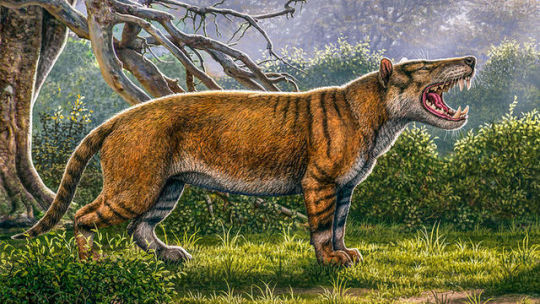
Africa’s largest mammalian carnivore had canines ‘the size of bananas’
Named Simbakubwa kutokaafrika, which means “big lion from Africa” in Swahili, the apex predator would have played a similar role in the region’s ecosystem as today’s lions, whose ancestors did not arrive in Africa until 3.7 million years later. Prior to that, Simbakubwa was one of the only land-dwelling carnivores in Africa, part of a group of giant extinct mammals called hyaenodonts. But whereas modern lions have only one pair of specialized, meat-slicing teeth on either side of their jaws, Simbakubwa had three, making it a formidable enemy...
Read more: Science News | AAAS
30 notes
·
View notes
Text
no human ever scritched a hyaenodont :c
1 note
·
View note
Text

lion? I’m sorry lion??
#simbakubwa kutokaafrika is NOT a lion#it's. most definitely a hyaenodont.#not a lion at all.#not even feliformes#paleontology#simbakubwa kutokaafrika
3 notes
·
View notes